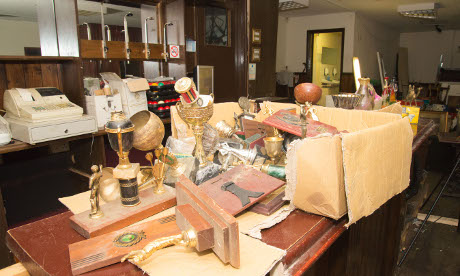The last days of Brooksby’s Snooker Hall

Brooksby’s Snooker Hall. Photograph: Alistair Siddons (all rights reserved)
The last few days of September, 2013. The door of the snooker hall on Brooksby’s walk is padlocked shut at night, but in the daytime, it’s a different story altogether. There’s activity inside, and lots of it.
I’ve long wondered what it looks like behind the red frontage, and now I have a compelling reason to go in. I’m foraging for wood and I’ve heard that everything has to go before Spar’s builders move in, or end up in their skips.
The photoshoot I commit to spreads over two half-days. Everywhere I look, my eyes fall on something of interest, and this slows me right down. Downstairs, piles of old books, CDs, vinyl singles, unwrapped magnetic recording tapes and LPs are neighbours with an incongruent array of discarded costume jewellery, cheap fashion boots, deckchairs, power tools, wardrobes, self-improvement and religious books, photographs, garden furniture, ornaments, decorating materials, pharmaceutical products and electrical test equipment. The place has recently been run as a store for a flea-market just in front, somewhere I’ve regularly bought stuff from over the last year or so.
But here, too, are boxes of trophies dating back to the eighties when this was self-evidently a busy community snooker, pool and darts club. A damaged corrugated cardboard box can’t contain this history, which spills out over the old bar. Close up, the trophies are coated with fine dust, but some still shine in the feeble fluorescent light. I imagine the various competitions that have taken place here, decades ago now, and wish the trophies could be returned to their respective winning teams or their families, instead of being junked.
I reach upstairs via an unlit staircase. After a few seconds here, I see the light switches for the bar, some of which are still working. Here is an abandoned wallet, complete with credit cards, a pair of high-heeled sandals, and an ancient address book crammed with phone numbers from the time when the 081 prefix was still in use. To me, such an object has an indeterminate value. It fascinates me to the extent that I want to keep it, but I know I have no relationship to its contents and I should define it as tat.
Now I see a set of dominoes – real ivory – stacks of snooker table triangles, playing cards, empty pint glasses, and hundreds of snooker balls. On the wall, a sign warns customers not to stand on the snooker tables and not to smoke over them. It’s so dark away from the bar that I can barely see any. I pass into the main playing area, completely unlit.
The switches back in the bar area only illuminate one table. I go round removing all the blown light bulbs and come back with replacements. After another hour, I can finally take pictures up there.
It’s so late in the timetable for clearing this place out that it seems highly unlikely these tables will now be sold. I’m wondering what it must feel like to pass a Stihl saw through a snooker table, whether it’s possible to do this dispassionately, as the builders will have to. I couldn’t do it.
I make an offer for a big dog’s leg of the old bar top, and an Edwardian door. They’ll be key components of a space I’m restyling on Chatsworth Road: it’s gratifying to know they’ll stay in the neighbourhood.
When I’m done, I pay a few quid for an old black-and-white security monitor and CCTV camera, a plaything for my son. It’s an odd feeling, walking out of that door for the last time. I wish the whole place could be preserved as a museum of oddities and local social history, exactly as it is.
Do you have any memories of the old snooker hall? If so, please share your comments below.
